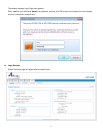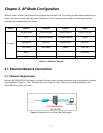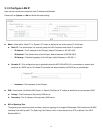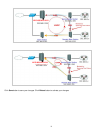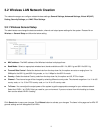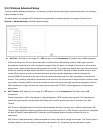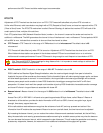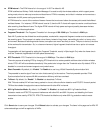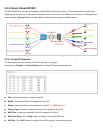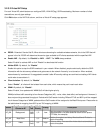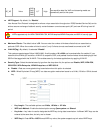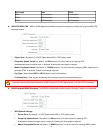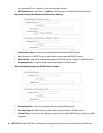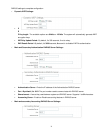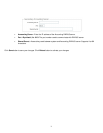24
DTIM Interval : The DTIM interval is in the range of 1~15. The default is 15.
DTIM is defined as Delivery Traffic Indication Message. It is used to notify the wireless stations, which support power
saving mode, when to wake up to receive multicast frame. DTIM is necessary and critical in wireless environment as a
mechanism to fulfill power-saving synchronization.
A DTIM interval is a count of the number of beacon frames that must occur before the access point sends the buffered
multicast frames. For instance, if DTIM Interval is set to 3, then the Wi-Fi clients will expect to receive a multicast frame
after receiving three Beacon frame. The higher DTIM interval will help power saving and possibly decrease wireless
throughput in multicast applications.
Fragment Threshold : The Fragment Threshold is in the range of 256~2346 byte. The default is 2346 byte.
Each Wi-Fi packet can be divided into smaller packets, marked with a sequential fragment number and re-assemble in
the receiving ends. The purpose is to make a short frame, instead of long frame, transmitting by radio in a heavy noisy
environment. Because of sending smaller frames, corruptions are much less likely to occur. The pros is obvious, the cons
is the overhead for transmission. So, in a clean environment, higher fragment threshold can be an option to increase
throughput.
Fragmentation will be triggered by setting the Fragment Threshold, usually in Byte-length. Only when the frame size is
over the Threshold, fragmentation will take place automatically.
RTS Threshold : RTS Threshold is in the range of 1~2346 byte. The default is 2346 byte.
The main purpose of enabling RTS by changing RTS threshold is to reduce possible collisions due to hidden wireless
clients. RTS in AP will be enabled automatically if the packet size is larger than the Threshold value. By default, RTS is
disabled in a normal environment supports non-jumbo frames.
Short Preamble : By default, it’s “Enable”. To Disable is to use Long 128-bit Preamble Synchronization field.
The preamble is used to signal "here is a train of data coming" to the receiver. The short preamble provides 72-bit
Synchronization field to improve WLAN transmission efficiency with less overhead.
Tx Burst : By default, it’s “Enable”. To Disable is to deactivate Tx Burst.
With TX burst enabled, AP will send many packets in a burst, without collision detection and RTS/CTS for each packet.
TX Burst have better throughput but cause interference with other APs in channel.
802.11g Protection Mode : By default, it’s “Enable”. To Disable is to deactivate 802.11g Protection Mode.
Protection mode use RTS/CTS to prevent interference with other APs and 802.11b peers, and disabling it will save
transmission time used by RTS/CTS. RTS/CTS threshold is effective only when 802.11g protection mode is made
enable.
Click Save button to save your changes. Click Reboot button to activate your changes. The items in this page are for AP's RF
advanced settings and will be applied to all VAPs.




